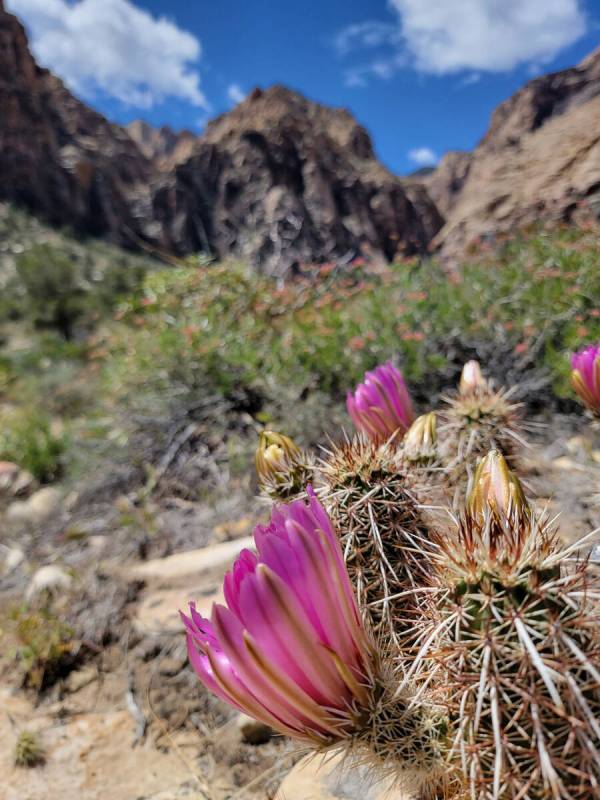The Mojave Cactus Bloom Tour

Soon I’ll trek into the Mojave Desert, once again chasing cactus colors: strawberry hedgehog cactus on spiky gray columns, pale yellow pencil cholla flowers at sunset. I’ll return in May to see Christmas-red blossoms atop Mojave mound cactus and burnt orange buckhorn cholla flowers. In the heat of June, I’ll see bright yellow barrel cactus blossoms nesting in protective spines.
The magic of Mojave springtime is apparent along the well-worn trails of Red Rock Canyon National Conservation Area and at Lake Mead National Recreation Area. Flower power is also found along less-traveled paths in spots like Wee Thump Joshua Tree Wilderness Area near Searchlight and in the hills near the community of Mountain Springs. Some cacti, including the Mojave prickly pear and Mojave mound, also bloom at lower pinyon-juniper elevations of the Mount Charleston area.
My checklist this spring includes catching subtle blooms in a teddy bear cholla forest, spotting the cheerful pink blossoms of a fishhook cactus and getting my timing right to witness a wide expanse of fuchsia-blooming beavertail cactus near Lake Mead. I’ve been waiting months for this return to the cactus-bloom wilderness. If there’s a springtime song in the air, it must be the flowers calling.
Confessions of a cactus-bloom stalker
Last spring, I added prizes to my cactus-bloom list when for the first time I saw and photographed the flowers of six cacti: pancake prickly pear, desert spinystar, Whipple cholla, cushion foxtail, desert pincushion and pencil cholla.
In March, I hiked the SMYC Trail in Red Rock Canyon National Conservation Area. The trail was new to me, and I noticed hundreds of large-paddled prickly pear cactus lining the path on the hillside and dotting the desert floor below. I made a mental note to return, hoping to photograph a bloom I hadn’t yet seen. Mid-April turned out to be too early, but I did see buds on the cacti and suspected they would be blooming toward the end of the month. The last week of April brought my reward: The festive peach blooms of the pancake prickly pear are now among the prettiest in my photo album. As luck would have it, I also spied a second unexpected new sight that day: the desert spinystar secretly blooming in a yellow ochre tone under a shady bush.
At the end of April, I also hit the mountain biking trails near Blue Diamond, where I took my first pictures of a Whipple cactus, which has handsome, waxy blooms in yellowish-green with a bit of red edging. Also blooming in fuchsia off the trail that day were beavertail, one of the most commonly seen cactus in Southern Nevada.
In mid-May, the hills near the Mountain Springs community yielded photos of the cushion foxtail, with flowers that look like small fuchsia sea anemones, as well as the delicate desert pincushion’s pink flowers. While not new to me, Mojave mound cactus also grow in the pinyon-juniper forest, some with dozens of brilliant red flowers that get a pollination assist from hummingbirds. I also found the strawberry hedgehog and elegant yellow Mojave prickly pear in this area
Between late May and early June, I stalked the budding pencil chollas in the morning hours before a friend helped me figure out that the delicate greenish-yellow flowers open around sunset near Late Night Trailhead, where manageable and meandering trails sprawl into the Las Vegas outback along state Highway 160. Dozens of pencil cholla, with branches that mimic coral, thrive in the area, along with hundreds of hardy buckhorn cholla.
Cactus experts speak out
Admiration for native cacti goes beyond the showy appearance of their blooms. “I think their most remarkable features are these various adaptations that make them durable enough to live in the harshest possible conditions,” says Mary Boyle, a Bureau of Land Management natural resource specialist for Red Rock Canyon and Sloan Canyon National Conservation Areas. “This relationship is so old, and the features are so unique and perfect.”
Cacti have a night-owl approach to survival. While the pores of ordinary plants open up during the day to soak up carbon dioxide through photosynthesis, cacti activate their stomata at night to save water while absorbing carbon dioxide. “During the summer dry season, some species, like beavertail, won’t open them at all until conditions are favorable,” Boyle said. “And cacti can tell, because when the soil is wet, the stomata (the tiny pores through which cacti “breathe” carbon dioxide) are open 24 hours.”
Cacti, which survive many years with minimum precipitation, are the ultimate desert dwellers.
“Cactus can regenerate into a new plant just by dropping a segment off the original plant,” says Carrie Norman, vegetation branch manager for Lake Mead National Recreation Area, who has worked with Mojave Desert plants for two decades. “I’ve seen barrel cactus growing straight out of a rock outcrop — they’re just amazing plants.”
Some cacti, Norman says, also serve as a prickly protective habitat for birds. The remnants of cactus wren nests can be found on buckhorn chollas at Red Rock. Cactus spines, especially on the local barrel cactus, also protect plants from herbivores and help reduce water loss by slowing air movement. And spines sometimes create latticework that provides essential shade.
Norman’s favorite springtime cactus is the fishhook. “They are so delicate,” she says, “and the beautiful ring of pink flowers on top is a sight to see.” Boyle, too, is an admirer of the fishhook and its relatives: “They have these luscious and bright, but comically oversized, flowers compared to the cactus body.”
If you head out on the cactus-bloom trail this year, you might find Norman and Boyle — and I’ll be out there somewhere, too. But most of all, what you’ll find is solitude among some of the most magnificent colors you’ve ever seen. Don’t leave your camera behind. ◆